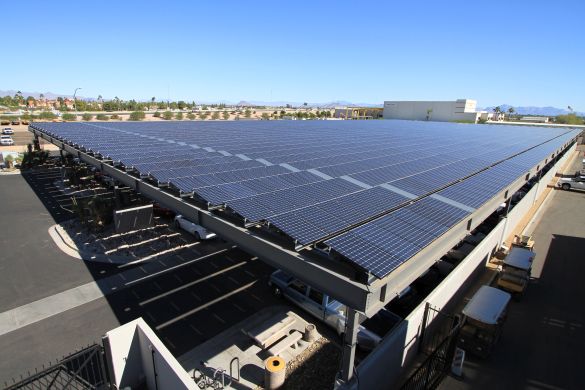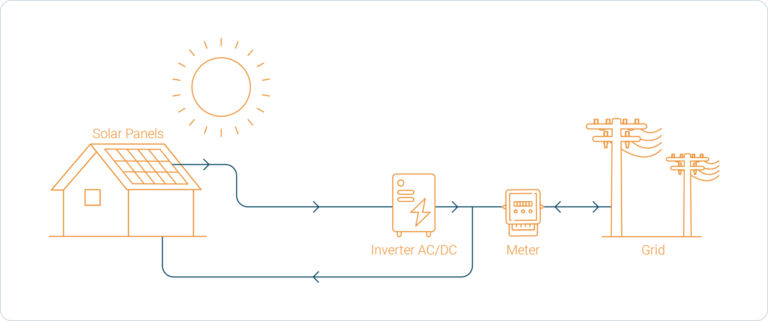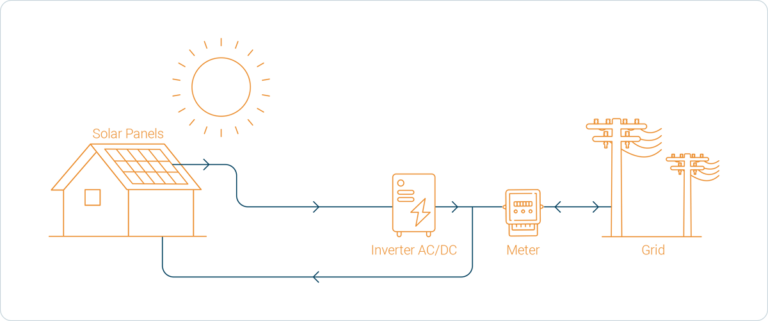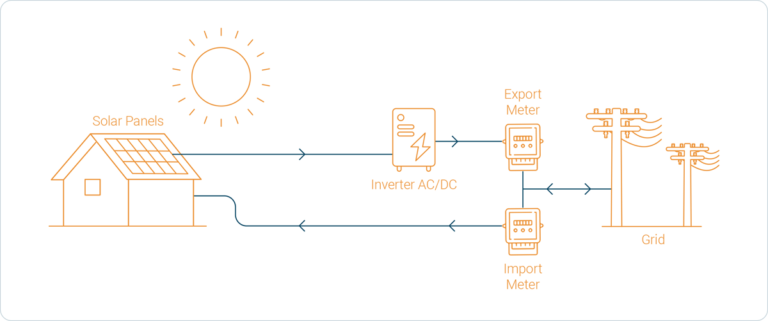Navigating the buying journey for solar
- By user

Understand your energy consumption and the solar metering mechanism
To determine if an investment into a rooftop solar PV system is right for you and what solar PV capacity is a good fit, it is important to understand your electricity usage and the type of solar metering mechanism that is applicable to you.
Solar net metering
If you are eligible for net metering, every unit of surplus solar energy exported to the grid has a monetary value equal to your electricity tariff rate. In this case your average monthly electricity consumption is a good starting point for sizing your solar PV system. You will find your monthly electricity consumption from your electricity bill. Keep in mind that your electricity usage will change between seasons, so you may want to look at electricity bills across multiple months of the year.
NET METERING
Grid-import is reduced through behind-the-meter consumption

Grid energy imported: As per meter import register (A)
Solar energy exported: As per meter export register (B)
Billing: (A X Consumer tariff) – (B X Consumer tariff)
Grid-import is reduced through behind-the-meter consumption of solar
Solar net feed-in
If you are located in a state where the solar net feed-in mechanism is applicable, then the unit of solar energy exported to the grid is credited at a tariff per unit of solar energy (INR/kWh). In case the net feed-in tariff is lower than your cost of solar energy generation you may limit your rooftop solar PV capacity and aim at maximizing your solar self-consumption while minimizing your export of solar energy to the grid. For optimal sizing of a rooftop solar PV system under the net feed-in mechanisms it will be important for you to gain an understanding of your typical electricity consumption over an entire day. Self-consumption occurs when your instantaneous solar energy generation is absorbed by your building’s electrical energy demand.
In case the net feed-in tariff is equal or higher than your cost of solar energy generation you may consider going for a larger rooftop solar capacity and need not be concerned with optimizing your solar system for self-consumption.
Typically the solar net feed-in tariffs are below the actual cost of solar energy generation and you will get the maximum benefits from your solar PV rooftop system if you design your system to maximise solar energy self-consumption during day-time hours. If you do not consume much electricity during the day, you can still make the most of your system by altering or tweaking the way you consume energy or by running appliances during peak daylight hours such as a washing machine, hot water heater, pumps etc. You may also consider adding a battery bank and store surplus solar energy and use it during evening or night-time hours.
NET FEED-IN/NET BILLING
Grid-import is reduced through behind-the-meter consumption of solar

Grid energy imported: As per meter import register (A)
Solar energy exported: As per meter export register (B)
Billing: (A X Consumer tariff) – (B X Net feed-in tariff)
Grid-import is reduced through behind-the-meter consumption of solar
Solar gross feed-in: Certain states in India offer a gross feed-in mechanism , where every unit of solar energy generated will be exported to the grid and sold to the utility. In this case no self-consumption of solar energy takes place. For rooftop solar systems under a gross feed-in mechanism your electricity consumption is irrelevant in regard to determining the solar capacity.
GROSS METERING
No reduction of grid-import through behind-the-meter consumption of solar

Grid energy imported: As per meter import register (A)
Solar energy exported: As per meter export register (B)
Billing: (A X Consumer tariff) – (B X Gross feed-in tariff)
Choose an installer
When choosing a solar installer, it pays to do a little research. State Nodal Agencies, to the Ministry for New and Renewable Energy and some electricity utilities do provide a list of enlisted solar installers. But these listings do not give indications on the standards of service provided by these enlisted installers. You may also ask in your personal network for recommended installers.
Site inspection
A site inspection is a great way for your solar installer to clearly determine the unique requirements for your solar system. Every building is different, so a pre-installation inspection is the best way to accurately identify:
- the optimal location for the solar panels,
- the available shade free roof area,
- the ideal location for the solar inverter and
- any additional requirements and associated costs for installation.
Quotes and contracts
We advise you to get multiple quotes from different solar installers, so you have a good basis for comparison of prices, recommended system capacities, additional service offering and customer experience. The quote will often form the basis for your contract or purchase order, so it is important that it provides you with the information you need.
Your quote should include:
- a site-specific system design
- a performance estimate
- an itemised list of components and products
- a clear breakdown of costs, including the total value of any discounts or rebates
- a listing of after sales services provided
- full terms and conditions of sale
Remember that once you have received the quote, you are under no obligation to go ahead with an installation.
Installation
The installation will have to be undertaken by the installers within the time period specified in the quotation. It is important that you are on site or at home for the installation of your system so you can meet your installation team and make sure you are present to sign-off on unforeseen changes required and learn how to operate and monitor your new solar system.
Appropriate documentation will be essential if you need to make warranty or insurance claims. A user manual should be provided by the installer on the day of installation. It is the responsibility of your solar installer to ensure that you have been provided with appropriate documentation.
You should receive:
- comprehensive information for safe and operation, maintenance, and optimisation of your solar system
- the shutdown and isolation procedure for emergencies and maintenance
- a recommended maintenance schedule for the system
- a copy of the installation commissioning sheet
- warranty information for each product installed at your property
- handbooks and product information for all equipment supplied
- a list of actions to be taken in the event of an earth fault alarm.
After the installation your solar installer should support you in getting the necessary safety certificates and grid interconnection permission – including the replacement of your energy meter, if required, from a unidirectional to a bi-directional energy meter.
Maintenance and servicing
Like all electrical equipment, maintenance of your solar system is critical to get the best value. Maintenance or servicing of solar systems is offered by many accredited installers and can include:
- panel cleaning and removal of debris
- system inspection and testing
- electrical checks to ensure all components are operating as intended
- reviewing the inverter display panel for recorded faults
- checking that access to the isolator switches has not been impeded
- making sure the emergency procedures for shutdown and isolation are clearly displayed
